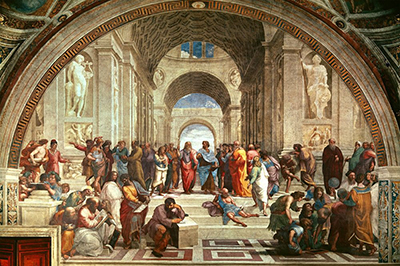In the year 1508, when Raphael Sanzio was just 25 years old, he was summoned to the Apostolic Palace (in Vatican City) by Pope Julius II for the purpose of conducting a commission.
The commission then turned out to be one of the most important and largest commissions during his lifetime. It was here that Sanzio painted the famous School of Athens in between 1509 and 1511, on the upper floor of the Apostolic Palace.
This Fresco styled mural painting is said to be one of the greatest paintings during the High Renaissance period and is also one of the best known works of Sanzio till date. In fact it was described by experts as the perfect embodiment of the classical spirit during the Renaissance period.
School of Athens, unlike Plato's Academy, is not an actual school. In other words, it is non-existent. It is rather a figment of Sanzio's imagination, an ideal community wherein various intellects from the entire classical world come together under a single roof to share ideas with one another and enlighten themselves in the process.
The School of Athens painting depicts the greatest scientists, mathematicians and philosophers from classical antiquity. Although these honorable individuals lived at different times, they are all seen together in the painting, which is more of a fantasy.
The painting is dedicated to philosophy as a pathway to knowledge; thus, all the philosophers shown in the painting have traditionally sought knowledge via an understanding of the root causes which drive knowledge. In other words, the theme of the fresco was the intention to seek knowledge via philosophy. There were four fresco paintings in the series (which represents branches of knowledge) but School of Athens is considered to be the best of the four!
The fresco painting comprises of 21 individuals (males) who are engaging in work, conversation or games in what appears to be a school. In between the entire scene depicted in the painting, one can see two prominent figures right in the middle or the central vanishing point of the architecture. These are none other than Aristotle (right) and Plato (left). Whilst Plato is shown as an old and wise man with grey hair holding a bound copy of Timaeus, Aristotle is a young and handsome student looking to his teacher. These two thinkers played an extremely important role as far as the Western thinking is concerned. In fact, their philosophies were incorporated into Christianity.
There are many statues within the school, as seen in the painting. One such statue is of Apollo, the Greek God of music, light and archery; he is seen holding a lyre. The statue of Athena or Minerva (in her Roman form), the goddess of wisdom, is also seen in the painting. Some of the Greek philosophers shown in the fresco are easier to recognize than the others. For instance, the renowned Greek mathematician Pythagoras, the Arabic philosopher Averroes, Euclid or Archimedes, Persian astronomer and philosopher Zoroaster, Cynic philosopher Diogenes, painter Sodoma, architect Bramante and so on. Figures who are not easily recognizable are considered to be representing philosophers who didn’t have their historical images.
This particular artwork is the pinnacle of Raphael's career, comparing favourably with other highlights from the High Renaissance, such as Michelangelo's Last Judgement, Leonardo da Vinci's The Last Supper and Botticelli's Primavera.
As a spectator viewing the School of Athens, you will find that the painting is done in such a way that you’d feel like you can step into the space, like walking into a theatrical setting. There is a domed area above the heads of Plato and Aristotle, checkered floor, horizontal planes and pillars, giving it an altogether rich feel of the place. What hints at the non-existence of the school would be the use of the open sky overhead and the fact that the architecture of the building is incomplete. Thus, this goes to show that the School of Athens is not really a physical building which existed. Even though the painting is not defined by the way the colors are used in it, it actually has a wide variety of colors, thereby giving the fresco a very vibrant look.
Sanzio is known to be a perfectly balanced painter and this fresco is the perfect demonstration of his talent. The brush strokes of the painting are simply flawless! The mood, tone and emotions depicted in the School of Athens painting shows how important it is to maintain the relationship between the figures. It also throws light on the chiaroscuro effects, which are the signature characteristics of High Renaissance art. In the painting, light is used in an interesting manner as it separates the concrete and the abstract. The light in question pours forth from the window and fills the entire room, which is logical and consistent with reality.
As far as the reception of the painting is concerned, the painting was received very well by the people. It received immediate success due to its thematic unity and sheer beauty. The reception of the painting wasn’t marred by any reservations pertaining to its content, unlike other monumental works during this era. What’s impressive about the painting is that by the end of 20th century and the beginning of 21st century, the painting was seen as one of the top culminations of art of the High Renaissance.
Raphael Sanzio is regarded as one of the greatest artists of all time. The Italian painter, architect and draughtsman is considered as one of the masters of the High Renaissance period, just like Michelangelo, Titian and Leonardo da Vinci. Apart from the School of Athens, other distinguished masterpieces during Sanzio’s career were Madonna, Disputation of the Holy Sacrament, the Parnassus and other frescoes in Rome. Apart from being a popular painter, Sanzio also ran a huge workshop, thus allowing him to dabble in different fields and work as a print designer and architect.




